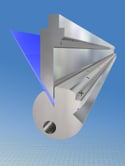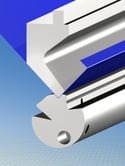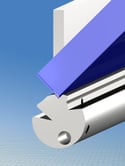Due to the widespread use of sheet metal in different capacities, we see machinery like hydraulic brake presses put to use in a variety of applications. In this blog, we look at how the signage industry puts brake presses to work.
Back in April, Roto-Die packed up our Model 5 bender and headed out to Las Vegas to attend the 2015 International Sign Expo. The event was largely dominated by banner signs and printed signage, but fabricated signs were not absent by any means. Out alongside the vinyl and plastic crowd were a fair share of sign producers who work with sheet metal, looking to shape and form just like everyone else.
As you can probably guess, the primary forming need for signage is channel forming letters, but there is also the need for other metal signs. With a press brake, operators have some flexibility with the different angular bends they can perform. Here are three techniques that sign fabricators can use to form their shapes:
Hemming
Hemming is important for a few reasons, such as reinforcing edges or connecting parts. In sign production, it’s particularly important for another reason: it neatens edges. There’s nothing appealing about a sign with jagged letters and shapes, and is more likely to tell inbound customers/visitors “Danger” instead of “Welcome.”
Channel Forming
For bending acute angles, channel forming with a v-shaped die would be an appropriate option. Additionally, if a sign producer is also tasked with installing the sign they produce, they’d likely need to build the struts for the sign mount. Channel forming will allow shops to form their own struts to the necessary specifications.
Box Forming
To form a box shape, an operator simply needs to make four bends. For deeper boxes, the operator may have to swap out a longer upper die, but since signs are typically going to be uniform in depth, there would only have to be a single change during the process.
Roto-Die is built with an adjustable lower die that makes changing operations as simple as a lever turn. For signage, this means that there’s very little delay between forming letters and shapes to forming the structural framework of the sign.
Are you working on, or previously worked on, a signage project that requires sheet metal bending? Comment below and tell us how you get it done!




